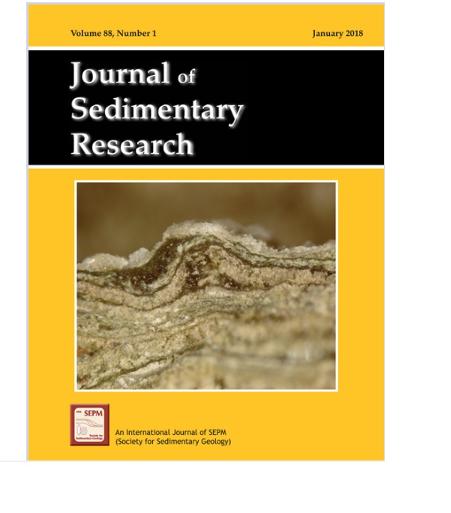Mostrar el registro sencillo del ítem
dc.contributor.author
Cuadrado, Diana Graciela

dc.contributor.author
Pan, Jeronimo

dc.date.available
2018-08-16T12:53:33Z
dc.date.issued
2018-01
dc.identifier.citation
Cuadrado, Diana Graciela; Pan, Jeronimo; Field observations on the evolution of reticulate patterns in microbial mats in a modern siliciclastic coastal environment; Society for Sedimentary Geology; Journal of Sedimentary Research - (Print); 88; 1; 1-2018; 24-37
dc.identifier.issn
1527-1404
dc.identifier.uri
http://hdl.handle.net/11336/55824
dc.description.abstract
Reticulate patterns often found in siliciclastic rocks as wrinkle structures may have been associated with or the product of biological activity. They are also present in modern environments, and laboratory experiments have elucidated the role of filamentous cyanobacteria in their formation, thus considering these microbes putatively as ecosystem engineers. The present study traces the evolution of reticulate structures in situ in a modern siliciclastic coastal sedimentary basin for over a year, under different hydrodynamic conditions. The results give new insights on the parameters involved in the formation and preservation of these microbial structures. Field observations documented the development of millimeter-size microbial reticulate structures with specific geometries. They were found in ephemeral ponds starting from two-dimensional submerged laminated cyanobacterial mats, and ultimately created three-dimensional protruding tufts and pinnacles in junctional positions after their desiccation. Reticulate patterns were formed on top of microbial mats four days after a storm flooding and two days after seawater vacated the area under calm conditions, by virtue of the motility of filamentous cyanobacteria. Through their subsequent consolidation they can be maintained in the form of reticulate structures and tufts for extended periods (months). These structures were found sharing an area with deformation sedimentary structures such as microbial folds, roll-ups, and ripped mats, formed under high energy. Therefore, calm settings such as those created by a shallow-water lamina seem to be a requisite for the formation of reticulate structures in the microbial mats, but once they become established, the microbial mats withstand high-energy hydrodynamic regimes. Our observations of modern structures and the sequential in situ study of their evolution provide linking references to laboratory and rock-record microbial reticulates, aiding in paleoenvironmental reconstruction.
dc.format
application/pdf
dc.language.iso
eng
dc.publisher
Society for Sedimentary Geology

dc.rights
info:eu-repo/semantics/openAccess
dc.rights.uri
https://creativecommons.org/licenses/by-nc-sa/2.5/ar/
dc.subject
Microbial Mats
dc.subject
Filamentous Cyanobacteria
dc.subject
Pinnacles And Tufts
dc.subject
Wrinkle Structures
dc.subject.classification
Geología

dc.subject.classification
Ciencias de la Tierra y relacionadas con el Medio Ambiente

dc.subject.classification
CIENCIAS NATURALES Y EXACTAS

dc.title
Field observations on the evolution of reticulate patterns in microbial mats in a modern siliciclastic coastal environment
dc.type
info:eu-repo/semantics/article
dc.type
info:ar-repo/semantics/artículo
dc.type
info:eu-repo/semantics/publishedVersion
dc.date.updated
2018-08-13T17:17:46Z
dc.journal.volume
88
dc.journal.number
1
dc.journal.pagination
24-37
dc.journal.pais
Estados Unidos

dc.journal.ciudad
Lawrence
dc.description.fil
Fil: Cuadrado, Diana Graciela. Consejo Nacional de Investigaciones Científicas y Técnicas. Centro Científico Tecnológico Conicet - Bahía Blanca. Instituto Argentino de Oceanografía. Universidad Nacional del Sur. Instituto Argentino de Oceanografía; Argentina
dc.description.fil
Fil: Pan, Jeronimo. Universidad Nacional de Mar del Plata; Argentina. Universidad de Buenos Aires. Facultad de Psicología. Cátedra de la Metodología de la Invest.cientifica Ii; Argentina. Consejo Nacional de Investigaciones Científicas y Técnicas; Argentina
dc.journal.title
Journal of Sedimentary Research - (Print)

dc.relation.alternativeid
info:eu-repo/semantics/altIdentifier/doi/http://dx.doi.org/10.2110/jsr.2017.79
dc.relation.alternativeid
info:eu-repo/semantics/altIdentifier/url/https://pubs.geoscienceworld.org/sepm/jsedres/article/88/1/24/525691/field-observations-on-the-evolution-of-reticulate
Archivos asociados
